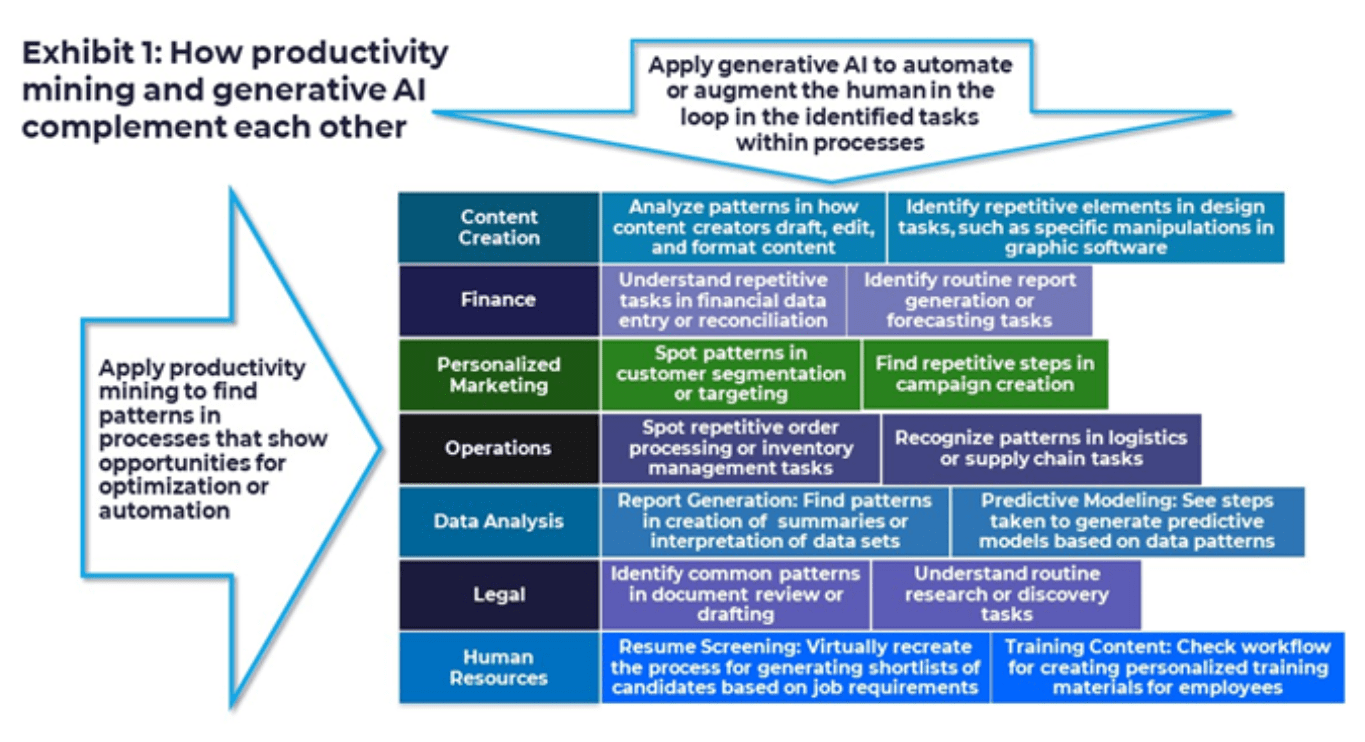Where business processes are concerned there are currently two game-changing technologies that stand out in their potential to modernize business operations: productivity mining and generative AI. When used together, these technologies present a paradigm shift for business process transformation and automation.
Understanding Productivity Mining
Productivity mining, a superset of task mining, captures and interprets business process workflows and patterns stemming from users’ interactions with software systems, and the way that the IT, the hardware and infrastructure responds to them. It is akin to holding up a mirror to the ‘as-is’ operational canvas, revealing previously unrecognized inefficiencies and, more importantly, identifying tasks that need modernization and/or are very suitable for automation.
The Role of Generative AI
Generative AI, epitomized by models such as GPT-4, has performed strongly, in automation of content creation – something that could not have been automated until recently. The models have shown versatility and a good deal of capability to augment humans, from crafting text, to designing, or generating code.
The Fusion of Two Titans
The combination of the two technologies can only be described as a game changer: with productivity mining uncovering potential areas of business process improvement and identifying opportunities for automation with generative AI. The latter can then be tapped to complete the task of automation. A breakdown of some of the opportunities includes:
- Content automation: Productivity mining highlights repetitive content-oriented tasks – e.g., writing standard emails or routine reports. It then identifies generative AI as the solution, that can adeptly auto-generate text to help human productivity.
- Decoding Data: Task mining can bring to light repetitive data interpretation tasks. When passed on to generative AI it can distil insights or generate summaries from vast datasets, ensuring analysis is swift, uniform and accurate.
- Customer Interactions: If patterns analysed by productivity mining suggest recurring responses by contact centre agents, generative AI can be used to build chatbots equipped to address these frequent queries, allowing human agents to tackle more complex challenges.
- Code Creation: If productivity mining finds regular patterns in coding, generative AI can be deployed to automate the relevant tasks e.g. augment humans by developing code, suggesting potential code structures or help by breaking tasks into simpler steps.
There are many other use cases. Exhibit 1 provides an overview of a selection of them.

Charting the Course of Innovation
A methodical approach is paramount to optimizing the amalgamation of productivity mining and generative AI:
- The Reconnaissance: Leverage productivity mining tools to thoroughly document interactions, to show the current state of processes and to spotlight anomalies.
- The Deep Dive: Sift through the captured data with productivity mining to find previously unknown automation goldmines, especially those that are time-intensive or prone to errors.
- Conceptualization: Once the automation opportunities have been identified, sketch out how generative AI can help, focusing on input-output dynamics and the training trajectory of the AI model.
- Operational Integration: Ensuring that your customized generative AI solution works in sync and where necessary is integrated with your existing systems, e.g., a relevant RPA robot, is paramount. Monitoring the automated process with productivity mining is key to validate outcomes and to ensure alignment with systems and business benchmarks.
- Evolution: Given the dynamic world of business and the rapid pace of development of technology, periodic reassessments of productivity mining insights and recalibration of the generative AI models are crucial to maintain relevance.
The Benefits
Marrying productivity mining with generative AI yields a range of benefits:
- Efficiency: Automation equates to diminished manual labour, translating to accelerated processes.
- Uniformity: Trained AI models should deliver consistent outputs, minimizing process variations that are easily and often unknowingly introduced by humans.
- Expansion Capabilities: As business needs grow, generative AI can be trained to augment more human activities and handle more requirements.
- Cost efficiency: In the long haul, automation could deliver efficiency savings, both in time and capital but the costs of licensing, running and maintaining the AI should definitely be part of the calculations.
- Job Fulfilment: By relegating repetitive tasks to AI, employees can channel their energies towards more meaningful activities, fostering improved job satisfaction and engagement at work.
Conclusion
Productivity mining and generative AI are strong technologies on their own, but together, they offer a paradigm shift in business process automation. They can help businesses think differently about how they work and boost innovation as well as process automation and human augmentation.
Taking this route needs careful planning, a good understanding of the business, and maybe expert advice to get the best results. That said, businesses thrive by embracing innovative technology. The fusion of productivity mining and generative AI offers unprecedented breakthroughs for them.
Want to understand how Generative AI and Productivity Mining can benefit your business? Contact us today to book a demo.
 Sarah Burnett
Sarah Burnett 